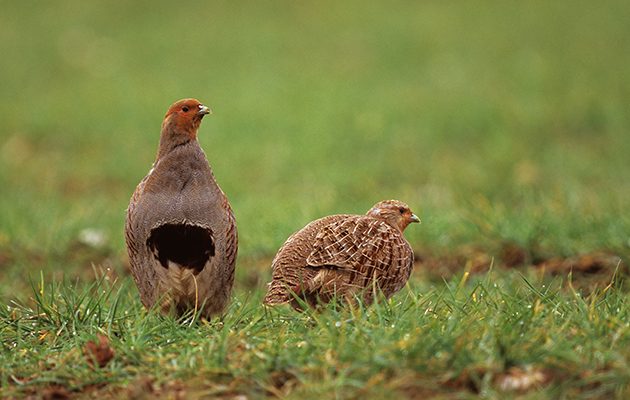Through initiatives such as the GWCT’s Partridge Count, farmers are starting to measure their own environmental impact, says Tim Field
The GWCT Partridge Count, the Great British Bee Count and the Big Farmland Bird Count are all examples of citizen science at its best. Enthuse participants and get big-data that ecologists can pick apart and use, says Tim Field.
For more on farming, read the life of a stockman in winter as a dark and dormant time can be made much happier with modern technologies.
CITIZEN SCIENCE
We have all heard it: an elder reflecting fondly on days gone by, when skylark were abundant, murmuration of starling blackened the sky, wild grey partridges provided plentiful sport… and then the sorrow of how it vanished over the past century. As time moves on I like to think the dialogue is changing. Reflection on the good old days is replaced with positive stories of our road to recovery. We speak of species conservation, habitat management and biodiversity restoration. This narrative is richest when articulated by farming folk but the credibility comes from quantified data and the ecological intricacies, an essential requirement if public money is to reward success in wildlife-friendly, sustainable farming.
My earliest encounter with this shift in attitude was on a cousin’s farm in Fife. While still farming commercially, Patrick Bowden-Smith has been committed since the 1980s to reinstating hedgerows, wetlands, ponds, cover crops and woodlands. He became the master of the grant application, passionately restoring significant tracts of wounded countryside and then sharing the trials and tribulations with many groups of visitors.
Meanwhile, nearby was birder extraordinaire Les Hatton, warden of the Eden Estuary. When he wasn’t darting across the East Neuk ringing and monitoring birds, Hatton kept a watchful eye on my university friends and me in our heyday of pre-tutorial wildfowling flights. I joined the bird-ringing crew on a few early mornings to help set out the nets in the darkness. There was always the wonderful anticipation before the sunrise ambush, excitedly followed by tagging, weighing and measuring of vital statistics, before releasing the birds to be caught, possibly, another day. These highly technical and carefully licensed bird ringers provide valuable data with which to evaluate conservation initiatives, some of which emerge as our Environmental Stewardship scheme options. It wasn’t long before Hatton, my thesis supervisor Professor Patterson and I were all catching, bagging and tagging all manner of creatures on Bowden-Smith’s farm, sharing our critique on his conservation successes or otherwise.
These pioneering examples, where practical conservation is aligned with research effort, can then be drawn upon to support government policy. For instance, subsidies for organic farms are to some degree justified by an Oxford University meta-analysis of 94 studies across 184 farms that found organic systems support 50% more pollinator species than non-organic systems. But is this sufficient evidence to allocate precious financial reward? It is unrealistic to expect Natural England to assess the outcomes of every farm participating in an agri-environment scheme but other quarters have been whispering about the prospect of farms measuring and declaring their environmental impact if they wish to be eligible for subsidies. Why not?
Beyond biodiversity enhancement there are other assessment headings that would add value: carbon sequestration, water management, animal health, pollution prevention and so on… which all fall under the recently coined phrase “public money for public goods”. These complex and far-reaching subjects would demand straightforward yet robust assessment metrics, so to most the concept may feel aspirational. Actually, without necessarily knowing it, many farmers would already be half way there.
April arrives and the grey partridge enthusiasts among farmers have been out scouting for pairs to note down and submit for the GWCT Partridge Count Scheme; the most comprehensive census of our most troubled farmland bird. I must confess, after a few years of never recording a grey I gave up. But as spring growth emerges from Daylesford’s seasonally drained wetland, I reflect on the site of our annual Big Farmland Bird Count (another of the GWCT’s “citizen science” exercises). We employ this method to record an asset otherwise unaccounted for, and disclose biodiversity as a complementary measure to traditional bottom-line figures.
These initiatives are citizen science at its best, enthusing participants and providing big-data that ecologists can pick apart and complement more targeted research. There’s a Great British Bee Count in June for the pollinator enthusiasts and other data collection schemes for aquatic life. Collated with existing assurance schemes and other readily available information – such as on-farm energy and water management, veterinary medication, other artificial inputs or a measure of soil organic matter – a suite of powerful data is assembled. While we applaud the innovation and enthusiasm of early adopters, and the knowledge and detailed data of expert ecologists, perhaps the Common Agricultural Policy can be replaced with a more engaging and collaborative scheme that gives participants the foundations to share a story of success.
Follow Tim and Agricology @agricology





